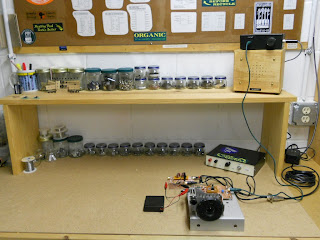
I have wanted a frequency counter for awhile now. When I seen this kit from Electronics DIY I couldn't resist. Under 40 dollars and it's good to 60 Mhz.
In all my years as an electronics hobbyist I don't think I have ever built a kit before! I started right out building things from scratch (or scrap). Kits always seemed a bit like cheating. But building a frequency counter with discrete logic chips seemed like a real pain, so I decided to try it.
It was fun! It went smoothly and worked the first time I plugged it in. The sensitivity is not the greatest and it appears to prefer square waves but I can work with this.
As is usually the case the toughest part was the enclosure. Have you ever tried to make a rectangular hole in aluminum?


